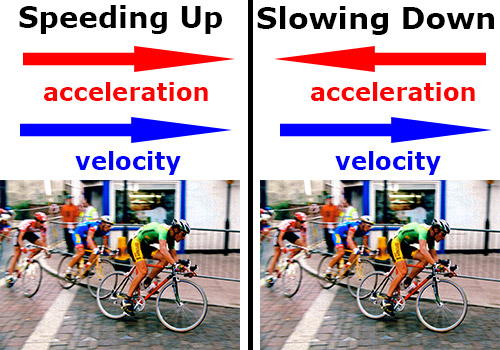Learn
Acceleration
The final aspect of motion we will discuss in this lesson is acceleration. Acceleration is another vector quantity a quantity that includes magnitude and direction.
Acceleration is the rate of change of velocity. Acceleration occurs when there is a change in speed or direction of an object or both.
Accelerating objects can be:
- Speeding up (also called positive acceleration)
- Slowing down (also called negative acceleration)
- Changing direction
Many times in our everyday conversations we use the term "acceleration" to indicate a change in speed. For example: "The car accelerated when the light turned green." This is a correct statement BUT as a physical science student, you must also remember that if a car changes directions and maintains the same speed that is also an example of acceleration. Acceleration can also mean slowing down (I know that's very different from how we use the term normally). Since acceleration is simply a change in velocity, that change could be to speed up or slow down.
Since acceleration is a vector, it must be written using:
- Magnitude
- Unit
- Direction

Image attribution: "Cycle Racing 1997" by Martin Pettitt is licensed under CC BY 2.0. Image has been changed from original.
Look at the bikers in this picture along with the arrows above them.
- The one on the right shows that if the velocity and acceleration are in the same direction the bikers will be going faster.
- However, as when acceleration and velocity are in opposite directions, the biker slows down.
Formula for Acceleration
We calculate acceleration by using the following:
| Acceleration equals change in velocity divided by time. |
|---|
The formula is written:
| a = Δv / t |
|---|
In this formula Δv means the change in velocity (the delta symbol Δ means "change in").
You can also calculate acceleration using:
| a = (final velocity - initial velocity) / time |
|---|
or
| a = (vf - vi) / t |
|---|
In this formula:
- vf = final velocity
- vi = initial velocity
Let's look at an example problem: Sara covers the last straight stretch of a race in 6 s. During that time, she speeds up from 4 m/s to 10 m/s. What was her acceleration?
- First let's identify the known values.
- vf = 10 m/s
- vi = 4 m/s
- t = 6 s
- Next, we can plug the known values into our formula.
a = (vf – vi) / t
a = (10 m/s – 4 m/s) / 6 s
a = 1 m/s2
So, Sara accelerated at 1 m/s2.
In terms of units, acceleration (in terms of a change in speed) is always measured in m/s2.
To learn more about the relationship between velocity and acceleration, open the video Kinematics (0:14). PBS login information.
- First, read the Background Essay listed under the Support Materials heading.
- Then, watch the video titled “Kinematics”.